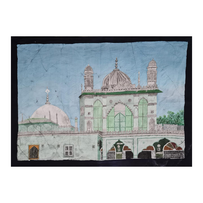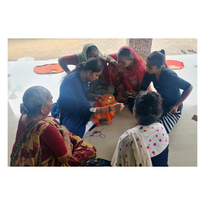AASTHA
हमारे कारीगर: Pride of India
A select of 5 stories of the 22 pieces curated
Tariq Ahmad Mir
Kashmir
Tariq Ahmad Mir is a third-generation sozni embroidery artist from Jammu and Kashmir. He belongs to the Budgam district, famous for its sozni work. He is the founder of Special Hands of Kashmir, a group of more than 100 artisans, many of whom are disabled.
He was diagnosed with muscular dystrophy very early in his life. After post graduation in Urdu, Mir Bhai decided to continue his family tradition and work towards preserving the art of Kashmir.
What started off with humiliation from all around, has today been a source of livelihood and refuge for many disabled people in the district. He has received several fellowships and awards, notably the highest honour bestowed by the state for his work towards art and culture.
Of the 3 commonly found Kashmiri embroideries, sozni is the one associated most with the state. It requires only fabric, needle, and thread as raw materials to begin with. On average, a piece can take up to 10 days to make. The tradition has been in Kashmir for more than 500 years.
"एक शॉल 72 से अधिक कारीगरों को रोजगार प्रदान करता है, जो बड़े प्यार से बनाई जाती है। मशीन से बनी चीज चार दिन की चांदनी जैसी है, कल कोई भरोसा नहीं। तो जब आप एक हाथ से बना सामान खरीदते हैं तो न सिरफ वो कला को संरक्षित करता है और आपके साथ रहने वाले को रोजगार देता है बल्की आप अपने लिए एक लंबा चलने वाला प्यार से बनाया उत्पाद ले जा रहा है।"
A typical sozni shawl provides employment for 72 artisans, handcrafted with love. Machine-made products, while cheaper, do not last long and never guarantee quality. When you purchase a handmade item, you are not only preserving the art and employing the person who lives with you, but you are also giving yourself a long-lasting product filled with love.
Chandana
Telangana
Chandana, a 19-year old ikat weaver from Koyyalagudem, Telangana, is one of the very few young artisans who are taking up their family heritage. She is a third-generation artisan. His grandfather handed the legacy to his father, who won several national awards for his work. Chandana's father set up a workshop, which today includes a workforce of 60 people, including tiers, dyers, and weavers. He trained them to become experts in their roles. In 2018, after he passed away, Chandana took the business into her own hands. Along with pursuing her education, she also manages the workshop with the help of her mother. She goes to college half the week, while the remaining 3 days she looks after the unit.
Her artisans faced immense hardship during the Covid-19, to support which they took loans. It was these difficulties due to which she decided to build her online presence. Today, she uses social media, e-commerce and other digital tools to ensure regular sales. Meena Appnender, her mentor supported her and connected with people like Aditi Shah Aman to guide her from time to time. Creative dignity also helped Chandana with market linkages, design knowledge and digital upskilling.
Chandana, however, has been seeing a decline in interest from the younger generation in the craft. She believes the craft will become inaccessible due to a lack of growth in monetary returns, immense hard work, and cheaper substitutes selling fraudulently. "A screen printed ikat costs INR 80 per meter, whereas a handloom ikat costs INR 300-500 per meter. If sellers do not inform their consumers about the difference, this may make them feel that buying hand-made is a waste of their money." It is thus that she is developing a transparent model with her customers. She provides complete information about the after-use of the products, the process of manufacture, and the difference between natural and chemical materials.
"People should invest in handmade products due to the painstaking process artisans undertake to make one piece. Every product is a collaboration between 3 artisans; one ties, one dyes and other weaves. It is the genius of makers to know how much a thread to dye to be able to generate required patterns. Handicrafts are inventions by local communities. Do we not pay well for other scientific innovations? Powerloom products are cheaper with no guarantee of hard work."
Shakil Ahmed Khatri
Gujarat
Shakil Bhai is a fifth-generation batik artist from Mundra Village in the Kutch area. His family of four and an eight-person workforce manage a workshop that produces shawls, sarees, dress fabrics, and dupattas.
Batik is a 5000-year-old craft whose origins are unknown. Both Indonesia and India are batik production centres, with unique styles. Techniques and materials utilised vary geographically as well. Batik in Kutch region was used in barter with farming groups, namely Ahir and Patel communities, in return for grains. Sadla, a traditional garment, is a 7-meter-long cloth with an extra 2-meter-long design in black and red that was once worn by women. From 1980 until 1995, Batik became synonymous with Lungi, a 2 metre wrap worn as nightwear by males. The latest models on the market were favoured by the next generation of rural communities. As a result, the commerce for Batik villages had plummeted, and they were on the point of closing down. Shakil Bhai's forebears then obtained an export order, reintroducing the family's skill into commerce.
Market changes led future generations to switch to chemical dyes. Shakil had enormous hurdles in reintroducing natural colours into practise due to a lack of documentation. Documentation he believes is a major asset to any practice. After 15 years of experimentation, Natural dyes now account for 75 percent of his revenues. One of the biggest limitations of employing natural dyes was the use of hot water during dying and removal of wax.
Shakil Bhai has a great love for painting. He explored the integration of painting and batik during his time at Kala Raksha in 2009 when he was pursuing his design education there. However, it was only in covid-19 that he had ample time to pursue his interests. He developed a unique style of painting in Batik.
Shakil Bhai believes that the youth prefer to work in industries rather than artisan workshops since it pays them more and requires less physical labour. With mobile phones becoming more widely available, the youth prefer working over the phone from the comfort of their own homes over any physical labour. He is also disappointed that many craftsmen have put screen printing devices beside their handcrafted manufacturing centres. When 4 people from a machine can manufacture 2000 mtr in a day, only 150 mtr can be produced by hand if 8 people are at work. "If craftsmen just start selling screen printing work falsely, they are effectively dying their own profession. ये तो इसी बात है जेसे, घर में आग लग गई घर के चिराग से ही।"
Kajal Makwana
In collaboration with Antarang,
Gujarat
Kajalben Makwana practises the Patwa thread craft as one of the artisans from Antarang-colouring lives with crafts. Kajal was born in a village near Palitana in Gujarat and never had the opportunity to attend school. Kajalben is divyang (deaf and mute). At a young age, she got married and today has a family of two children. In her marriage, she was subjected to domestic violence. She was adamant about achieving financial independence so that she could provide a good life for her children. Her battling spirit inspired her to seek out a network of individuals who can help achieve her goals.
Kajal joined Antarang, a part of Microsign Products, a cable tyre and fastener producer, in 2016. For the last 48 years, Microsign has been employing Divyangs. She started her journey with straight stitches on machines, gradually learnt hand embroidery and then was further trained with the patwa technique. She now uses the same technique to make rakhis, fashion accessories, and torans.
Kajalben initially felt it difficult to trust the organisation. Anatarang's team provided her with a safe place to develop and confide in them. Kajal gradually taught other employees sign language too.
Today, she manages Antarang's upcycling project and Patwa's threaded craft jewellery. She trains other women in different villages and women from self-help groups in the production of upcycled products for home furnishing products and patwa-threaded craft jewellery. She also represents Antarang at different events and exhibitions. The exposure to the market and travelling to different cities has given her a new identity and confidence. Kajal Bens tells other women seeking to develop their independence to "Have confidence in yourself and make the first move. Then there's the whole tribe of like-minded people to help you out. "
Antarang has touched the lives of many such rural women by helping them gain financial independence and respect in the eyes of society. They have planted the belief in divang women like Kajalben that " You don't have to live on charity but learn a skill and can earn a dignified life from the same. "Craft can beautifully be the means of earning and converting your disability into a powerful ability."
Why Handmade? मैंने खुद 2016 से पहले कभी भी हस्तनिर्मित उत्पाद का इस्तेमाल नहीं किया। यह मेरे लिए महंगा था। लेकिन अंतरांग में शामिल होने के बाद मैंने महसूस किया कि हम जैसे कितने लोगों को हस्तनिर्मित उत्पाद के कारण रोजगार के साधन मिलते हैं।
Adil Khatri
Gujarat
Bandhani was practised for many generations in Adil Khatri's family until it was standardised as a business model by his uncle 40 years ago. His uncle developed and traded traditional bandhani designs. Adil Bhai joined his business in 2011. For 2 years, he learned business management and craftsmanship. Somaiya Kala Vidya changed the direction of his family business.
The course exposed him to ways of creative expansion. Since 2013, he has been creating theme-based collections as well as mixing traditional and modern styles. On his visit to the Taj Mahal, he was left awestruck with the patterns, skills, and details. This inspired him to create a theme-based bandhani collection last year. (swipe 2, 3)
Adil has started his own brand, Nilak, meaning green. Traditional bandhani was dyed in bright red with scattered green dots to bring contrast and emphasis to the piece, and hence became his choice for naming his brand. (swipe 4)
पहले के क्राफ्ट में भी डिज़ाइन तो होता था । ऐसे ही कुछ भी नहीं बनाते थे I For example: Chandrogni, a traditional motif inspired by the moon and stars. While he believes design sensibilities are different geographically, culturally, and across social groups, fashion influencers create a difference in the market demand.
With every passing day, the interest of young practitioners is decreasing, and in the coming future, handicrafts will become expensive as the number of makers will drastically fall. The work of craft is not respected enough. There is no formal degree or education modules in schools which create awareness amongst the masses about the industry. Thus, in our communities, pursuing engineering and medicine are preferred despite equal monetary gains.
"कभी भी हाथ से बना काम एक आदमी नहीं बना। वो बहुत सारे लोगो की मिली झूली मेहनत होती है। जेसे बर्थडे पे बहार से लाए गिफ्ट से ज्यादा हाथ से बना कार्ड हममें अच्छा लगता है ठीक वे ही हैंडीक्राफ्ट दिल से जुड़ा रखता है I"
Adil Khatri's story is one of many stories which lay bare the intricate and historical linkages between design and craft. Adil Khatri has been nominated as the icon of the week by NDTV. To vote, download the India Money Freedom App from the play store. Login to support Adil Bhai on his journey of experimentation and innovation.
All stories are available on the link below





























